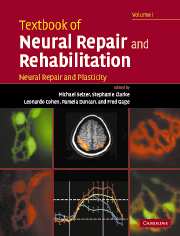Book contents
- Frontmatter
- Contents
- Contents (contents of Volume II)
- Preface
- Contributors (contributors of Volume I)
- Contributors (contributors of Volume II)
- Neural repair and rehabilitation: an introduction
- Section A Neural plasticity
- Section A1 Cellular and molecular mechanisms of neural plasticity
- Section A2 Functional plasticity in CNS system
- 6 Plasticity of mature and developing somatosensory systems
- 7 Activity-dependent plasticity in the intact spinal cord
- 8 Plasticity of cerebral motor functions: implications for repair and rehabilitation
- 9 Plasticity in visual connections: retinal ganglion cell axonal development and regeneration
- 10 Plasticity in auditory functions
- 11 Cross-modal plasticity in sensory systems
- 12 Attentional modulation of cortical plasticity
- Section A3 Plasticity after injury to the CNS
- Section B1 Neural repair
- Section B2 Determinants of regeneration in the injured nervous system
- Section B3 Promotion of regeneration in the injured nervous system
- Section B4 Translational research: application to human neural injury
- Index
7 - Activity-dependent plasticity in the intact spinal cord
from Section A2 - Functional plasticity in CNS system
Published online by Cambridge University Press: 05 March 2012
- Frontmatter
- Contents
- Contents (contents of Volume II)
- Preface
- Contributors (contributors of Volume I)
- Contributors (contributors of Volume II)
- Neural repair and rehabilitation: an introduction
- Section A Neural plasticity
- Section A1 Cellular and molecular mechanisms of neural plasticity
- Section A2 Functional plasticity in CNS system
- 6 Plasticity of mature and developing somatosensory systems
- 7 Activity-dependent plasticity in the intact spinal cord
- 8 Plasticity of cerebral motor functions: implications for repair and rehabilitation
- 9 Plasticity in visual connections: retinal ganglion cell axonal development and regeneration
- 10 Plasticity in auditory functions
- 11 Cross-modal plasticity in sensory systems
- 12 Attentional modulation of cortical plasticity
- Section A3 Plasticity after injury to the CNS
- Section B1 Neural repair
- Section B2 Determinants of regeneration in the injured nervous system
- Section B3 Promotion of regeneration in the injured nervous system
- Section B4 Translational research: application to human neural injury
- Index
Summary
Introduction
The traditional view of the spinal cord
A major feature of neuroscience over the past 30 years has been the steadily growing recognition of the ubiquity of activity-dependent plasticity in the central nervous system (CNS). Recognition of the multiple mechanisms of synaptic and neuronal plasticity, of their existence in many different regions, and of the frequency with which they are activated, has wholly overturned the traditional view of a hardwired CNS that stores the effects of past experience by a limited set of mechanisms and only in a few specialized places. This new understanding, however, still focuses mainly on the brain, and excludes, intentionally or otherwise, the spinal cord. As late as the 18th century, the spinal cord was seen as simply a big well-protected nerve through which the brain interacts with the world; and it is still commonly assumed to be merely a stable way station between the brain and the periphery, the repository of nothing more than a few fixed reflexes. The original rationale for this 19th-century assumption was as much theological as scientific (reviewed in Wolpaw and Tennissen, 2001). Nevertheless, it remains embedded in neuroscientific theory and research. Activity-dependent plasticity, or persistent CNS modification that results from past experience and affects future behavior, is still considered by many neuroscientists to be a purely supraspinal capacity.
The recognition of spinal cord plasticity
It is now abundantly clear that the spinal cord possesses capacities for activity-dependent plasticity comparable to those found elsewhere in the CNS.
Keywords
- Type
- Chapter
- Information
- Textbook of Neural Repair and Rehabilitation , pp. 109 - 125Publisher: Cambridge University PressPrint publication year: 2006
- 2
- Cited by



